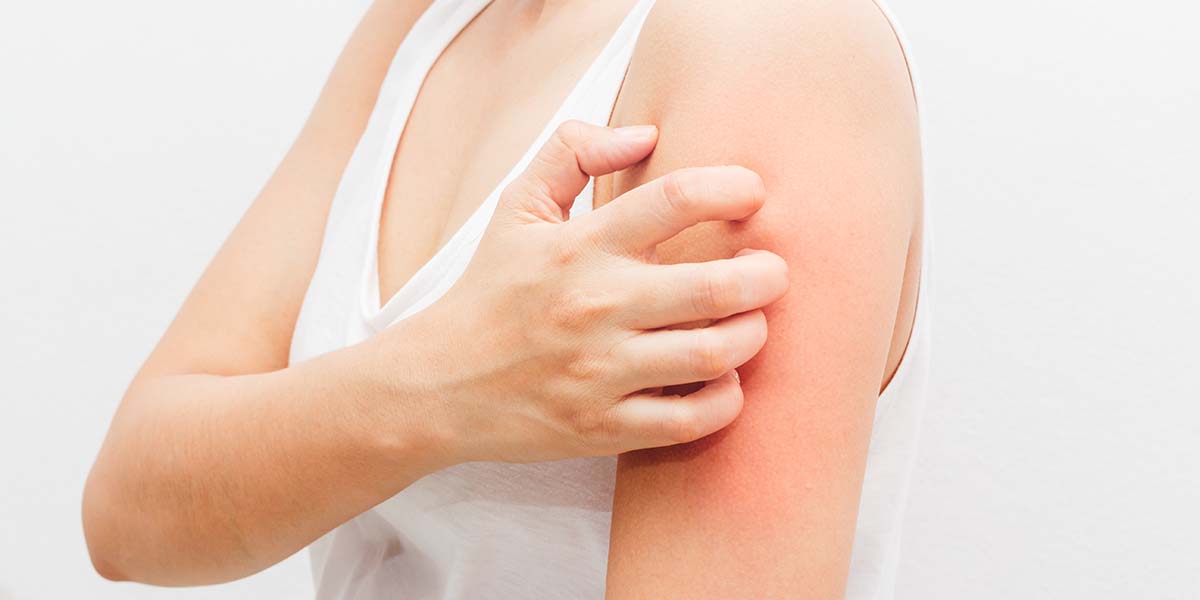Valentine’s Day may be known for lovers…but for allergy sufferers, it marks the day they…

Fun in the Sun? Not If You’re Allergic!
Allergies to the Sun and Sunscreen Can Put a Damper on Summer Activities
By Dr. Manav Segal, Board Certified Allergist and Immunologist
Summer is around the corner, temps are rising, days are longer, and getting out to enjoy sunshine and fresh air is one of the simple pleasures we can still look forward to in 2020.
Or is it?
Exposure to sunlight can carry unpleasant consequences for anyone allergic to the sun or sunscreen.
At this time of year, people may notice a rash, ranging from minor red bumps, to more prominent patches and possibly including blisters on various areas of the body, including arms, legs, chest, hands and feet, but usually not the face. Called PMLE, or polymorphous light eruption, the rash is a reaction to UV light, usually from the sun, but it can also happen after using a tanning bed. Itching can be significant and is usually treated with topical anti-inflammatory steroids.
Symptoms of sun allergy (sometimes referred to as “sun poisoning”), which can also include a headache, fever or nausea, tend to begin in early spring and diminish as the weeks progress due to what is called “skin hardening.”
“Skin” hardening describes the fact that people who experience PMLE appear to be able to tolerate sun exposure better as we move from spring to summer. Their skin becomes “hardened” to the UV light and they no longer experience the bumpy, itchy rashes. The skin does not actually become hard.
Another type of allergic response to the sun is solar urticaria, a rare variant of chronic hives. Hives develop within 5-10 minutes of sun exposure. They are red, raised, and itchy areas that resolve within 24 hours. The hives are triggered by exposure to UV or visible light.
Treatment includes antihistamines to prevent or treat the hives. Light therapy can be helpful in some cases. Omalizumab (Xolair), a neutralizing antibody to the protein responsible for allergic reactions, is also effective.
A sun allergy is not the same as sunburn. Sunburn results from overexposure of the skin to sunlight and typically manifests as reddened skin developing three to five hours after exposure, is often painful for a day or so, and usually improves after three or four days. More severe sunburns may result in peeling of damaged skin.
Here’s how to tell the difference between PMLE and sunburn:
- PMLE is itchy with a bumpy rash that may include blisters
- Sunburn is smooth, tight-feeling skin that is painful at onset and may be warm to the touch
Although PMLE is benign, there is the slight potential for permanent discoloration of the skin or minor scarring. It’s more likely that patients will experience depression or anxiety as a result of not being able to participate in favorite activities.
As with other allergies, sun allergy can be treated by therapy to start building “skin hardening” tolerance. Patients who wish to avoid the symptoms can start light therapy earlier in the year; treatment is typically two to three times a week for a four-to-six week period.
Another factor that may interfere with summer fun is an allergy to sunscreen.
Some people have a reaction when they use sunscreens with certain ingredients. The combination of those ingredients and sun exposure leads to contact dermatitis symptoms such as itchy bumps, swelling and pain, similar to the symptoms of sun allergy. According to the American College of Allergy, Asthma & Immunology, oxybenzone is the ingredient most likely to cause a reaction to sunscreen. Other ingredients to avoid include benzophenones, cinnamates, and dibenzoylmethanes. Zinc oxide and titanium dioxide provide effective protection with low risk of reaction. Those who are sensitive to sunscreen should also avoid products that contain PABA or added fragrance.
Here are simple strategies to help reduce or avoid symptoms from sun or sunscreen allergies:
- Avoid the sun from 10 a.m. to 4 p.m. whenever possible
- Wear protective clothing such as long-sleeved shirts and pants with SPF
- Apply a broad-spectrum sunscreen with at least 30 SPF frequently and generously
- Use sunscreen with zinc oxide or titanium dioxide that offer the greatest range of UV protection.
https://www.mayoclinic.org/diseases-conditions/sun-allergy/symptoms-causes/syc-20378077
“Red itchy bumps from wearing sunscreen outside?”, American College of Allergy, Asthma & Immunology



